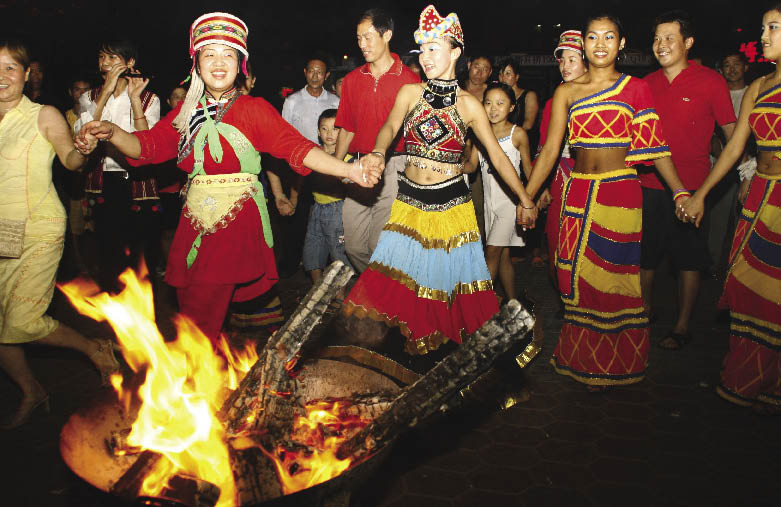|
On the second day, each village holds activities that include singing, dancing, wrestling and archery. They also feast on the local snacks that are on sale, along with handicrafts and living necessities, at market stalls nearby the village.
Horseracing and bullfighting are main features of this grand occasion. Yi competitors are seasoned horsemen who have trained their steeds to jump flaming torch hurdles. Winning bulls earn their owners great honor.
For younger villagers this second day of the festival is their chance to pick a life partner. Young men signify whom they wish to marry by snatching away their desired sweetheart's embroidered belt. If she is willing, the girl invites her suitor into the woods where they express their feelings through musical dialogues. But if she simply puts on another belt and allows the man to keep the one he has "stolen," this means she is simply not interested.
The Naxi custom on this day is for each family to add three pine torches to the main torch, making it taller, to ward off ill fortune and evil spirits. Other ethnic groups follow the tradition whereby elders give younger farmers the benefit of their farming experience.
The festival reaches its climax on the night of the third day. Villagers gather in the square to the sound of beating drums and the soaring flames of their torches turn the sky red.
Dressed in their finest costumes bedecked with sparkling ornaments, everyone sings as they dance hand-in-hand around the towering torch to express their gratitude for life and good wishes for the coming year.
The whole village resounds with the music that the men play on the traditional three-stringed instrument sanxian, accompanied by gongs, drums and cries of joy as the women dance.
The Bai tradition is for villagers to sprinkle rosin on one another's torches. The fire this generates is believed to banish wickedness and disease. The young throw rosin on elders' torches to wish them a long and healthy life, and they in turn sprinkle it on those of the younger villagers to express love and care. It is another way for young men to express amorous intentions to the girls of their choice. Unwilling to end their revelries, the exultant crowd sings and dances the whole night through.
More Than a Festival
 |
|
Folk dancing at the gala. |
A major ceremonious event, the time-honored Torch Festival showcases a wide scope of folk arts.
The singing of the heroic epic King of the Copper Drum is another ceremonious aspect of the festival. Also known as The Copper Drum Song, the epic has always been an aspect of the Yi rituals as the copper drum was an important sacrifice in ancient times.
Villagers also sing ballads celebrating fire, handed down over generations. Most famous are Song of Fire, Spirit Summoning Tune and Song of Sacrifice. Each has set lyrics but the style of singing varies between solo and antiphony.
These folk arts that are part of the Torch Festival express the people's creative talent, positive attitude towards life, and close affinity with nature.
Now an item of national intangible cultural heritage, this oriental carnival is becoming internationally well known. People from all over the world come to join the gala and share in local residents' celebration of life and nature. It is no longer simply a local festival but a bridge linking peoples that live in remote mountainous regions with the rest of the world.
| 